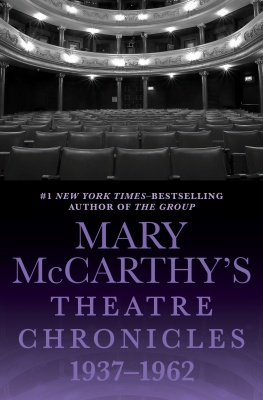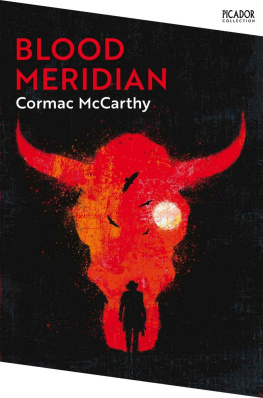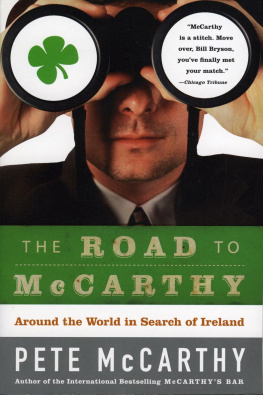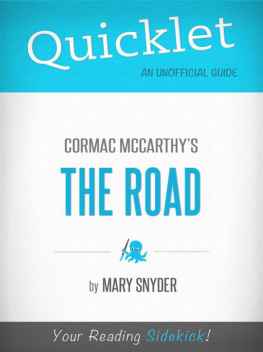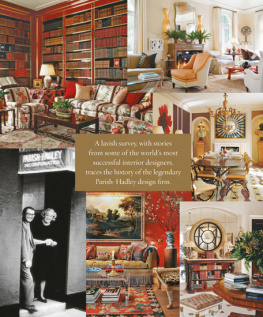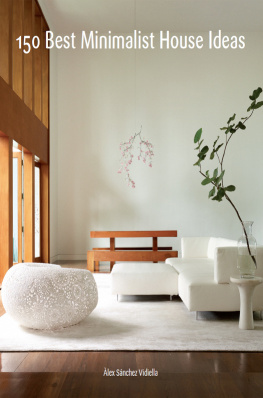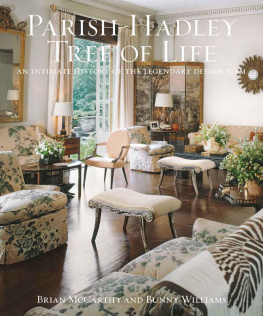LUMINOUS INTERIORS
BRIAN J . M C CARTHY
LUMINOUS INTERIORS
BRIAN J . M C CARTHY
WRITTEN WITH MARC KRISTAL
FOREWORD BY BUNNY WILLIAMS
Stewart, Tabori & Chang | New York
I DEDICATE THIS BOOK TO MY WONDERFUL CLIENTS (WHOSE PRIVACY I RESPECTYOU KNOW WHO YOU ARE) WHO ENTRUST IN US THEIR CONFIDENCE TO SEE THROUGH THEIR EYES AND ALLOW US TO MAKE THEIR DREAMS COME TRUE AND BELIEVE IN OUR VISION TO HELP SHAPE THEIR LIVES. THEY ARE TRULY THE PATRONS OF OUR ART.
FOREWORD
In the early 1980s, a very tall handsome twenty-three-year-old young man, a recent graduate of design school, applied for a position at Parish Hadley, where I was one of the senior designers. Needing help desperately on my projects, he was given the job of my assistant. His name was Brian McCarthy. Coming fresh from design school, his idea of a color scheme was various shades of mauve, but within weeks the most beautiful fabrics and trims began to appear in the office after his shopping expeditions. Albert Hadley soon saw his amazing potential and took him under his wing to assist him on his projects. This was the beginning, but it was Brians passion for design and all the decorative arts, his passion for architecture and art that has made him the great designer he is today.
The richness of Brians work comes from a curiosity and knowledge of all periods of design. He is a constant student: reading, traveling, absorbing the best, and, in the end, creating his own interpretations. He has traveled the world seeking the greatest artisans, whose work he incorporates into his projects. He has an incredible eye and passion for art, always seeking new talent. Because of this knowledge his projects are always unique and the variety is that of a truly great designer.
Recently, Brian, David Kleinberg, and I have come together on various occasions to celebrate the life of Albert Hadley. It has been like siblings finding each other after a period of time and having the most wonderful moments talking about and exploring our upbringing. Like Albert, Brians body of work is brilliant, innovative, and timeless, and will be an inspiration to many for years to come. This book will become a classic.
Bunny Williams
INTRODUCTION
Though Ive had my own interior design firm since 1991, the nine residences selected for this book were all completed within the last six years, and represent the crystallization of my particular design vision: the direction in which Ive begun to move (and the variety of styles I employ), after more than thirty years on the job, as a mature practitioner of my craft. Yet the process of selectionof going back and scrutinizing dozens of projects, and considering each in the context of a larger body of workhas reminded me that what I do today is the outcome of a long process of discovery, a creative and personal voyage that reaches back in time to a largely vanished world, and has taught me invaluable, and occasionally unexpected, lessons.
Surprisingly (even to me), while I always had a lively interest in houses, and an even greater one in art, I never had the slightest intention of doing what I do today. My desire was to be on the back of a horse: I began show jumping at the age of ten, and continued for nearly forty years; I confess I would have loved to have been an Olympian. But my parents, a naval architect and a social worker, didnt consider horseman to be a proper profession, and, after spending a year full-time on the equestrian circuit after high school, I didnt believe it was the life for me, either. My academic record was pretty undistinguished, but riding had taught me that if I applied myself to something, I could be good at it. So I put my confidence in my drawing and painting skills and decided to tackle art school.
Pratt Institute in Brooklyn, which I loved the moment I arrived for my admissions interview, proved to be the perfect environment. When I started, I had the idea that I might want to be an industrial designer. But your foundation year at Pratt is structured to offer a comprehensive introduction to all of the institutions departments, and once I saw what the interior design classes were all about, the prospect of
In my New York office, a painting by Kati Heck hangs above a Jean-Michel Frankinspired marquetry mantelpiece
executed in mirror. The bookcases (an identical one is on the other side of the fireplace) are of my design. In my New York office, a painting by Kati Heck hangs above a Jean-Michel
Frankinspired marquetry mantelpiece executed in mirror. The bookcases
(an identical one is on the other side of the fireplace) are of my design.
reinventing the electric toothbrush quickly lost its appeal. I became fascinated instead with developing ways of life of creating original worlds people could inhabit gracefully, in sync with their personalities and needs, and, not least, with style. Pratt Institute in Brooklyn, which I loved the moment I arrived for my admissions interview, proved to be the perfect environment. When I started, I had the idea that I might want to be an industrial designer. But your foundation year at Pratt is structured to offer a comprehensive introduction to all of the institutions departments, and once I saw what the interior design classes were all about, the prospect of reinventing the electric toothbrush quickly lost its appeal. I became fascinated instead with developing ways of life of creating original worlds people could inhabit gracefully, in sync with their personalities and needs, and, not least, with style.
I loved the work and, applying myself, started to be good at it. But it wasnt until the second half of my junior year that I began defining my own perspective, in a manner that differentiated my approach from those of the other students. At the time, enthusiasm for postmodernism was at its peak; I drew on the movementits embrace of difference, its lack of certainty about what does and does not constitute good designbut wanted to take it further by introducing a measure of eclecticism into the postmodern vocabulary: eighteenth- and nineteenth-century elements that resonated in a contemporary decorative environment without extracting light-spiritedness or comfort. By my senior year I was, by the standards of the day, a true subversive: visiting antique shops and galleries in Manhattan, and getting to know the dealers, who opened my eyes to new realms of possibility.
Upon graduation in 1983, I was lucky enough to land a job at Parish-Hadley Associates, one of the most influential interior design firms of its time, founded by two legendary principalsSister Parish and Albert Hadleywho came out of entirely different traditions that each made very much their own. Sisters style belonged to patrician England, to which she added an American twist, bringing things like patchwork quilts into classical interiors and leavening their formality with a welcome whimsy. Albert, conversely, was a modernist whose antecedents were Jean-Michel Frank, Van Day Truex, and, later, Billy Baldwin; he was a patient, thoughtful listener whose designs were at once shot through with excitement and entirely, blissfully livable. Whether working separately or together, Sister and Albert captured the eclecticism I so appreciated. They were never rigid in their handling of materials or styles, but rather mixed the things they loved surprisingly and without the slightest hint of the academys chill.
I was fortunate, too, to have gone to work when I did, as the interior design world was very different back then than it is today. There were fewer firmsthe ones that existed mostly had long, colorful historiesand the business itself was quieter: less aggressive, more genteel. The nature of the clientele, too, at least at Parish-
Hadley, was different. Those who knocked on Sister and Alberts door came from families that had worked with decorators, often the same ones, for generations; as people who understood that interior design is a craft, our clients back then tended to be less overtly demanding, and more attuned to the idea of a creative process that involved trial and error, give and take. Dont misunderstand me: the individuals I collaborate with today (as youll discover in the pages to come) are exceptionally generous in their trust, and involve themselves in the work with energy and imagination. But times have changed, and in the high-pressure, big-money environment of the present day, people sometimes treat decorators as service providers and nothing more. I was fortunate to come up at a time when clients allowed us to find our way to the richness and subtlety that elevates an interior from the well-done to the magical. I was fortunate, too, to have gone to work when I did, as the interior design world was very different back then than it is today. There were fewer firmsthe ones that existed mostly had long, colorful historiesand the business itself was quieter: less aggressive, more genteel. The nature of the clientele, too, at least at Parish- Hadley, was different. Those who knocked on Sister and Alberts door came from families that had worked with decorators, often the same ones, for generations; as people who understood that interior design is a craft, our clients back then tended to be less overtly demanding, and more attuned to the idea of a creative process that involved trial and error, give and take. Dont misunderstand me: the individuals I collaborate with today (as youll discover in the pages to come) are exceptionally generous in their trust, and involve themselves in the work with energy and imagination. But times have changed, and in the high-pressure, big-money environment of the present day, people sometimes treat decorators as service providers and nothing more. I was fortunate to come up at a time when clients allowed us to find our way to the richness and subtlety that elevates an interior from the well-done to the magical.



